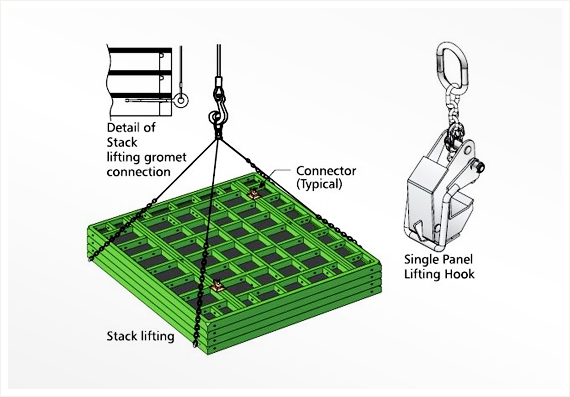 Contact us today...+971 4 347 4466
Contact us today...+971 4 347 4466The ADSF Wall Form system consists, mainly, of a modular steel frame with a plywood or plastic laminate panel facing, push-pull prop, scaffold bracket, alignment coupler, compensation waler, tie rod and lifting hook.The heart of the system is the modular panel with a smooth-surfaced cladding attached to one side of a purpose-designed steel frame. Plywood panels could be used as cladding but Tabla recommends composite plastic panels to increase the ease of stripping and vastly extend the panel’s cycling life span. Powder coated frames made of cold roll-forming steel supports the cladding.
Connection between the modular panels is accomplished through the use of the ADSF alignment coupler which greatly improves working efficiency when compared to time-consuming bolts or cumbersome U-clips. Additionally, compensation walers used at panel connection locations strengthen the integral rigidity of the wall forms.Essential advantages of the ADSF Wall Form System are: high cycling turnover , easy operation, reasonable load, convenient storage and transportation, as well as low cumulative costs.
With ADSF standardization of mechanized components, formwork erection has never been easier. A worker needs only a hammer to finish the job. Modular components can be stacked together for convenient and safe lifts of multiple panels to the work deck. ADSF Wall Form panels are designed to nest for stacking and automatically align holes where the load can be secured with tie rods.Holes located at each of the four corners are provided for securely attaching the lifting grommet. The ADSF Wall panels are designed to act as a base for the lift,negating the use of wood pallets.
For single panel lifts,the Lifting Hookis designed specifically to match the profile of the ADSF Wall Form framework. This design avoids stress to the panel and reduces any negative effect of force to the frame during lifting.
Illustrated above are the four optimum tie locations.Ties can, however,be located in any position along the built-in horizontal waler as necessary to avoid rebar or any other obstruction with in the form.


